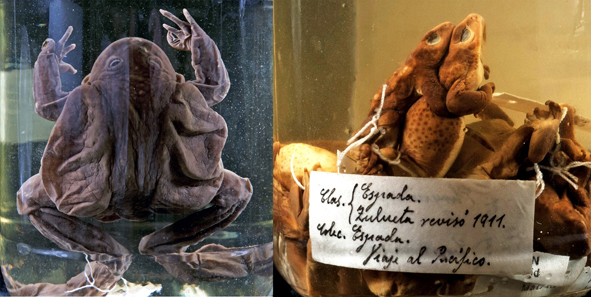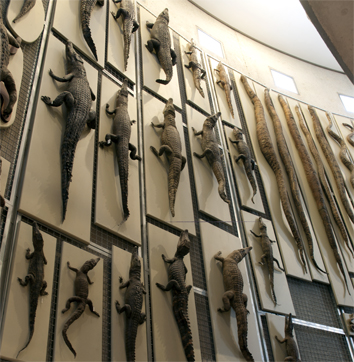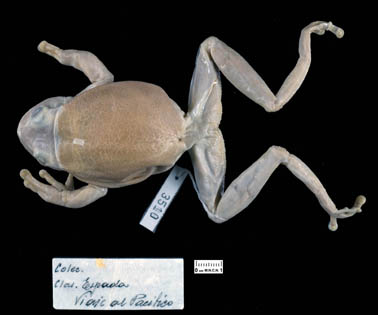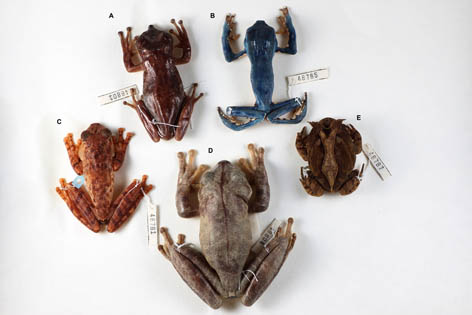Herpetology
The Herpetology collection is home to the two large vertebrate groups that are traditionally studied under the discipline of Herpetology, these are, amphibians and reptiles.

Representation of the morphological diversity of some of the groups preserved in the MNCN collection.
Amphibians constitute a distinct zoological group by the presence of a combination of unique characteristics amongst terrestrial vertebrates. The presence of metamorphosis, a larval stage, diverse methods of reproduction, cutaneous respiration, glandular and naked skin, dependency on wet environments in order to carry out their biological cycle, systems of communication, and by the threats they face in regards to conservation, are all characteristics that have stood out to biologists through the generations. Currently, amphibians encapsulate around 8223 different species y and they can be represented by 3 large, morphologically different groups: (1) Gymnophiona (generally known as Caecilians), which has 214 species, distributed mainly around neotropical areas, (2) Caudata, (newts and frogs) made of 759 species distributed through Holarctic and neotropical regions, and (3) Anura (frogs and toads), the most diverse and widely distributed group, with 7,250 species.

Two nearly extinct species, threatened by the xhytrid fungus Batrachochytrium dendrobatidis, and conserved by the MNCN. The specimen to the left, Telmatobius culeus, is the oldest case of the presence of chytrid in amphibians. On the right, Atelopus ignescens, formerly abundant in the plains of Quito and its surroundings (Ecuador) and now almost extinct.
On the other side, reptiles or Sauropsida, are a group of amniotes that, with the exception of pirds,can be understood as 11,341 species, separated into groups: Rhynchocephalia (tuatara) with only one species, Crocodilia with 26, Testudines with 360, and Squamata (scaled) with 10,954 species including saurians, amphisbaenids and snakes. This last group is especially relevant in the field of medicine, as some of them are able to synthesise poison.
The Herpetology Collection in the National Museum of Natural Sciences (MNCN-CSIC) houses more than 70,000 specimens , in which 751 species of amphibians have been counted, and 918 species of reptiles. The ´type´ material housed comprises pf 723 specimens of amphibians and reptiles, corresponding to 104 taxa.
The spceimens are mostly conserve din fluid (ethanol of 70%; apart from the amphibials larvae, which are held in 10% formolin). The rest of the conserved material can be grouped as part of either (1) the collection of disarticulated skeletons conserved in a dry environment, made up of 2,900 specimens, (2) the collection of transparent and dyed specimens, consisting of 3,613 specimens maintained in glycerin, or (3) the collection of naturalized specimens of great historical value but of lesser use by researchers, consisting of 182 specimens of reptiles.
The origins of the collection can be traced to 1771, in the cabinet of Natural History founded by King Carlos III after acquiring the collection from Pedro Franco Dávila. Amongst the first specimens conserved in the collection were some naturalised crocodiles, referenced by the cabinet's first dissector, Juan Bautista Bru, in 1784, and the sea turtles Caretta caretta (Linnaeus, 1758), Chelonia mydas (Linnaeus, 1758), and Eretmochelys imbricata (Linnaeus, 1758), sent from Cuba by the naturalist Antonio Parra between 1788 and 1793.

A small example of the naturalised specimens displayed in the Royal Cabinet of Natural History in the MNCN.
Most of the curated material comes from the Iberian Peninsula as well as North Africa, South America, the Philippines and Equatorial Guinea, territories which were historically under the influence of Spain. In this context, the collection has been nourished by important donations from scientific campaigns, such as the Pacific Science Commission (1862-1865), which includes the species described by Jiménez de la Espada,whose type specimens have formed a large part of the collection, and the Permanent Collection, for the study of Northwest Africa, at the beginning of 1900, where the material collected by Manuel Martínez de la Escalera, who contributed material from both Morocco and Equatorial Guinea (Rio Muní), stands out.

Holotype of the Nototrema testudineum Jiménez de la Espada, 1870, collected during the Pacific Science Commission. Currently Gatrotheca testudinea.
The collecction has continued growing with additions from herpetologists like Eduardo Boscá between 1879 y 1882, or more recently form musuem researchers (Borja Sanchíz, Alfredo Salvador, Mario García París, Ignacio De la Riva, amonst others), aas well as significant donations and exchanges iwth other museums and research centres. .

Display of some of the specimens rrecieved through exchanges with other institutions A) Aparasphenodon brunoi (Miranda Ribeiro, 1920), B) Phyllomedusa burmeisteri (Boulenger, 1882), C) Itapotihyla lagsdorffii (Duméril y Bibron, 1841), D) Boana faber (Wied-Neuwied, 1824), E) Proceratophrys boiei (Wied-Neuwied, 1824).
Featured pieces
Exemplary type
Collection staff
Conservadora
Marta Calvo Revuelta
mcalvo@mncn.csic.es





